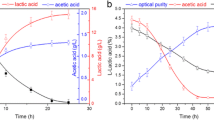Abstract
Of six strains of lactic acid-producing alkaliphilic microorganisms, Halolactibacillus halophilus was most efficient. It produced the highest concentration and yield of lactic acid, with minimal amounts of acetic and formic acid when sucrose and glucose were used as substrate. Mannose and xylose were poorly utilized. In batch fermentation at 30°C, pH 9 with 4 and 8% (w/v) sucrose, lactic acid was produced at 37.7 and 65.8 g l−1, with yields of 95 and 83%, respectively. Likewise, when 4 and 8% (w/v) glucose were used, 33.4 and 59.6 g lactic acid l−1 were produced with 85 and 76% yields, respectively. l-(+)-lactic acid had an optical purity of 98.8% (from sucrose) and 98.3% (from glucose).



Similar content being viewed by others
References
Akerberg C, Hofvendahl K, Zacchi G, Hagerdal BH (1998) Modeling the influence of pH, temperature, glucose, and lactic acid concentrations on the kinetics of lactic acid production by Lactococcus lactis ssp. lactis ATCC 19435 in whole wheat flour. Appl Microbiol Biotechnol 49:682–690
Berry AR, Franco CMM, Zhang W, Middelberg APJ (1999) Growth and lactic acid production in batch culture of Lactobacillus rhamnosus in a defined medium. Biotechnol Lett 21:163–167
Bulut S, Elibol M, Ozer D (2004) Effect of different carbon sources on l (+)-lactic acid production by Rhizopus oryzae. Biochem Eng J 21:33–37
Cao SJ, Qu JH, Yang JS, Qing S, Yuan HL (2008) Halolactibacillus alkaliphilus sp.nov., a moderately alkaliphilic and halophilic bacterium isolated from a soda lake in Inner Mongolia, China, and emended description of the genus Halolactibacillus. Int J Syst Evol Microbiol 58:2169–2173
Ishikawa M, Nakajima K, Yanagi M, Yamamoto Y, Yamasato K (2003) Marinilactibacillus psychrotolerans gen. nov., sp. nov., a halophilic and alkaliphilic marine lactic acid bacterium isolated from marine organisms in temperate and subtropical areas of Japan. Int J Syst Evol Microbiol 53:711–720
Ishikawa M, Nakajima K, Itamiya Y, Furukawa S, Yamamoto Y, Yamasato K (2005) Halolactibacillus halophilus gen. nov., and Halolactibacillus miurensis sp.nov., halophilic and alkaliphilic marine lactic acid bacteria constituting a phylogenetic lineage in Bacillus rRNA group 1. Int J Syst Evol Microbiol 55:2427–2439
Litchfield JH (1996) Microbiological production of lactic acid. Adv Appl Microbiol 42:48–95
Nakajima K, Hirota K, Nodasaka Y, Yumoto I (2005) Alkalibacterium iburiense sp. nov., an obligate alkaliphile that reduces an indigo dye. Int J Syst Evol Microbiol 55:1525–1530
Tanaka K, Komiyama A, Sonomoto K, Ishizaki A, Hall SJ, Stanbury PF (2002) Two different pathway for d-xylose metabolism and the effect of xylose concentration on the yield coefficient of l-lactic acid in mixed-acid fermentation by the lactic acid bacterium Lactococcus lactis 10–1. Appl Microbiol Biotechnol 60:160–167
Taniguchi M, Tokunaga T, Horiuchi K, Hoshino K, Sakai K, Tanaka T (2004) Production of l-lactic acid from a mixture of xylose and glucose by co-cultivation of lactic acid bacteria. Appl Microbiol Biotechnol 66:160–165
Timbuntam W, Sriroth K, Tokiwa Y (2006) Lactic acid production from sugar-cane juice by a newly isolated Lactobacillus sp. Biotechnol Lett 28:811–814
Toffin L, Zink K, Kato C, Pignet P, Bidaul A, Bienvenu N, Birrien JL, Prieur D (2005) Marinilactibacillus piezotolerans sp. nov., a novel marine lactic acid bacterium isolated from deep sub-seafloor sediment of the Nankai Trough. Int J Syst Evol Microbiol 55:345–351
Yoo IK, Chang HN, Lee EG, Chang YK, Moon SH (1996) Effect of pH on the production of lactic acid and secondary product in batch cultures of Lactobacillus casei. J Microbiol Biotechnol 6:482–486
Yumoto I, Hirota K, Nodasaka Y, Yokota Y, Hoshino T, Nakajima K (2004) Alkalibacterium psychrotolerans sp. nov., a psychrotolerant obligate alkaliphile that reduces an indigo dye. Int J Syst Evol Microbiol 54:2379–2383
Yumoto I, Hirota K, Nodasaka Y, Yutaka T, Nakajima K (2008) Alkalibacterium incidireducens sp. nov., an obligate alkaliphile that reduces indigo dye. Int J Syst Evol Microbiol 58:901–905
Author information
Authors and Affiliations
Corresponding author
Rights and permissions
About this article
Cite this article
Calabia, B.P., Tokiwa, Y. & Aiba, S. Fermentative production of l-(+)-lactic acid by an alkaliphilic marine microorganism. Biotechnol Lett 33, 1429–1433 (2011). https://doi.org/10.1007/s10529-011-0573-0
Received:
Accepted:
Published:
Issue Date:
DOI: https://doi.org/10.1007/s10529-011-0573-0




